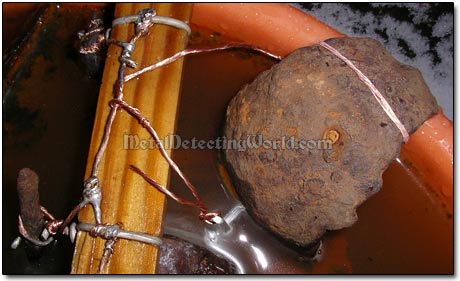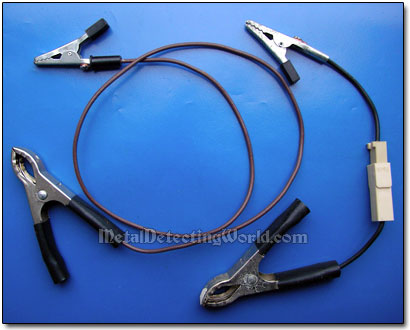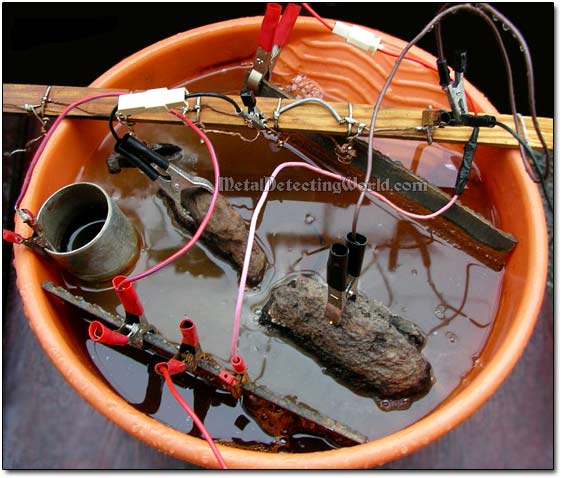Electrolytic Removal of Rust - A Detailed Illustrated Tutorial, page 36
7. Multiple-Part Electrolysis: Combining Small- and Medium-Sized Relics in Setup, Multiple-Part De-Rusting of Medium-Sized Artifacts
4) Combining Small- and Medium-Sized Relics in Multiple-Part Electrolysis
If you have, for example, a dozen of small-sized artifacts and one medium-sized relic to be derusted, you can still electrolyzed them all at once using the multiple-part hanger. All you have to do is to prepare a piece of bare wire of a sufficient length to connect the medium-sized relic to the cathode grid on the hanger, and maybe place an additional anode into the container.
The grid would allow to connect as many additional cathode wires to it as needed, so you can drop in more artifacts to derust as long as they all fit into the container without jeopardizing the operation. Do not forget to leave enough room in the container so a large, encompassing field of voltage could develop (see details on page 14).
Medium-Sized Iron Relics Are Included into Multiple-Part Electrolysis

5) Multiple-Part Electrolysis of Medium-Sized Artifacts
When you have a few medium-sized artifacts, you can derust two or three of them at once if you use additional cathode connecting sets (see details in the "Making Connecting Sets" section on page 10).
Additional Pair of Cathode Connecting Sets

Just like with the cathode grid on the multi-part hanger where all aluminum loops, connecting wires, and small-sized artifacts form one big cathode, the medium-sized artifacts are connected to each other for the same purpose. And this big cathode is connected to a single power source as well. The cathode grid can be conveniently used for connecting the mid-sized artifacts to it using the cathode connecting sets.
Multiple-Part Electrolysis Setup with Two Medium-Sized Artifacts

Because an average medium-sized artifact is somewhat cumbersome and takes more space, it is prone to tilt under its own weight, immediately touching the anode(s). This usually happens when the heavily rusted artifacts, especially the ones of a round shape, such as medieval blooms made of bog iron, are not properly set up in the container. The following describes a usual mishap.
At some point during electrolysis, a thick layer of rust begins coming off the relic's bottom part which had supported the artifact's balance. When the relic's weight crushes all the loosened rust underneath, the relic loses its initial balance and bumps into one of the surrounding anodes, causing SHORT-CIRCUITING.
To avoid accidental movements of the artifacts inside the vat, and to keep them stationary all the time during the process, use non-conductive stands, supports and separators that do not block the "line of sight" (see details in the "Line of Sight" section on page 20). Be creative and use whatever you can find among your household items.
For instance, I use two massive glass ashtrays to keep the artifacts balanced, and to insulate them from the bottom sludge. To prevent tilting of the artifacts towards the anodes, the golf tees can be put in between the artifacts and the anodes on both sides if possible. To avoid accidental short-circuiting, you may want to cover the anodes with pieces of the plastic window screen.
After you prepared all components of your multiple-part electrolytic setup, follow the operational steps described in chapter 3 - "Preparations and Assembly of Electrolytic Setup", starting on page 16.